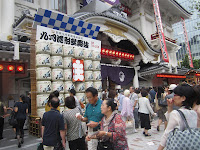Tokyo will host the Olympic Games in 2020. It
will be the 2nd time to host the Games (after 1964).
The opening and closing ceremonies,
together with track and field competitions, will be held at the National Olympic
Stadium in Shinjuku ward as in 1964. Other games will be held in the new
facilities to be built or renovated mainly in the Tokyo Bay area.
 Today, I walked “2020 Olympic sites” in the
Bay area.
Today, I walked “2020 Olympic sites” in the
Bay area.
I first visited Yumenoshima in Koto ward.
It is an artificial island built in the 1950s and 60s. Enormous volume of
garbage was carried here from many places in Tokyo and piled up to make lands.
The place was infamously called Gominoshima (Garbage island), not Yumenoshima
(Dream island).
Today, garbage has turned into soil. There
is a large park spread in the area and various facilities are built in it.
Large Halloween pumpkins were placed in the
garden of a tropical plant dome and children were playing with them.
I also visited an exhibition site of Daigo
Fukuryu Maru (Lucky Dragon 5), a tune boat which was exposed to and
contaminated by nuclear fallout from US nuke test in 1954.
Basketball, badminton, archery, equestrian
games will be held here in Yumenoshima area.
I moved westwards to Tatsumi, where swimming
will be held. Water polo will be also played in the area.
Highways run around the area. There are
tall apartments, office buildings and factories in the area. Construction works
were underway.
I continued walking through Shinonome to
Ariake. Volleyball, gymnastics, cycling and tennis will be played here in
Ariake. Ariake Coliseum, which currently has 10,000 seats, and other facilities
around it will be used for tennis games in 2020.
It was crowded today as the final match of
Toray Pan Pacific Open was held today.
I moved westwards and arrived at Odaiba,
where Triathlon and beach volley will be played.
Nearly half of the games will be played in
the area I walked today.






















































